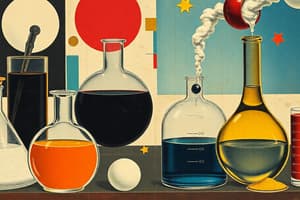Podcast
Questions and Answers
What defines a substance in a liquid state?
What defines a substance in a liquid state?
Increased temperature and pressure
Which state of matter has particles that are closely packed together?
Which state of matter has particles that are closely packed together?
Solids
What characteristic differentiates gases from liquids in terms of particle connection?
What characteristic differentiates gases from liquids in terms of particle connection?
Gases have loosely connected particles
Give an example of a substance in a solid state.
Give an example of a substance in a solid state.
How do the particles in a liquid behave compared to those in a solid?
How do the particles in a liquid behave compared to those in a solid?
Flashcards are hidden until you start studying
Study Notes
States of Matter: Understanding Liquids, Gases, and Solids
Introduction
In the realm of chemistry and physics, the concept of states of matter refers to the distinct ways in which matter can exist. Three primary states of matter are commonly observed in everyday life: solids, liquids, and gases. These classifications are determined by the arrangement of atoms, molecules, or ions within a substance.
Solids
In a solid state, the constituent particles (ions, atoms, or molecules) are closely packed together, with strong forces holding them in place. The particles cannot move freely but can only vibrate, resulting in a substance with a stable, definite shape and a definite volume. Examples of solids include elements like sodium chloride (NaCl) and substances like quartz. When a solid changes its state due to external factors, such as heat or pressure, it evolves into another state of matter, such as a liquid or a gas.
Liquids
A liquid state arises when a substance experiences increased temperature and pressure, causing the particles to gain sufficient energy to move about and create random motion. Although a liquid has a definite volume (assuming no change in temperature or air pressure), it lacks a specific shape and instead conforms to the shape of its container. Notable examples of liquid substances include water, alcohol, and oil.
Gases
In the gas state, a substance's particles are loosely connected and exhibit reduced intermolecular forces. Unlike solids and liquids, gases possess neither a definite shape nor volume. They readily adapt to fill the entirety of their containers, making them highly compressible. Examples of gases include oxygen, nitrogen, and helium.
Conclusion
Understanding the different states of matter provides valuable insights into how substances behave under varying conditions. By recognizing the distinctions between solids, liquids, and gases, scientists and researchers can better predict and control the properties and reactions of materials, leading to advancements in numerous fields, including chemistry, physics, and engineering.
Studying That Suits You
Use AI to generate personalized quizzes and flashcards to suit your learning preferences.




